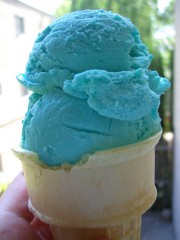Yo Kass answered
The Italian word for 'ice-cream' is gelato, which actually means 'frozen', but is generally used to refer to the various types of frozen cream-based sweet.
Gelato vs ice-cream
Outside Italy, distinction is made between the term gelato and 'ice-cream' because of the slightly different artisanal process involved in making Italian-style gelato. The main thing that distinguishes gelato from ice-cream is a lower butterfat content.
Also, the machines used to make gelato turn at a slower speed and introduce less air into the mixture, resulting in thicker, denser textures. Finally, gelato tends to be held at slightly warmer temperatures than most ice-creams. This is so the gelato has a softer, runnier quality.
Gelato-culture
Another thing that sets Italy apart when it comes to frozen deserts is its 'gelato-culture'. In the hot and humid Italian evenings, you're likely to find throngs of people crowded outside gelaterie (jel-at-erie-eh) or 'ice-cream parlours' enjoying their favourite frozen desert. The gelateria of a town can often be just as much of a 'nightspot' as the pubs and bars. You'll often find amorous adolescents sitting on parked mopeds sharing an ice-cream, whilst families and young children mill about.
Types of Gelato
The wide variety of flavours in which gelato is available makes the local gelateria a must-visit spot on the tourist trail. The gelateria is often a tantalizingly colourful affair, with a glass cabinet housing tubs of overflowing, brightly-coloured and extremely tempting gelato being the main attraction.
Below is a quick guide of the kind of flavours you can expect to try:
Chocolate Lovers Rather than simply having one chocolate ice-cream option, gelaterie often have a whole section of flavours dedicated to the mighty chocolate. They vary from the must-haves like cioccolato fondente through to flavours named after brands of popular Italian confectionery such as bacio [batch-oh] (meaning kiss- named after the hazlenut-centered chocolate made by Perugina).
Rather than simply having one chocolate ice-cream option, gelaterie often have a whole section of flavours dedicated to the mighty chocolate. They vary from the must-haves like cioccolato fondente through to flavours named after brands of popular Italian confectionery such as bacio [batch-oh] (meaning kiss- named after the hazlenut-centered chocolate made by Perugina).
In recent years, more experimental chocolate flavours have emerged with cioccolato all’azteca being one example- an Aztec inspired combination of dark chocolate, chilli peppers and cinnamon!
Going nuts? One of the most popular nut-based gelati is the *nocciola [noh-cho-la]*or hazelnut flavour. As opposed to flavours like nutella, nocciola is pure, unadulterated hazelnut- with no chocolate involved, although the nuttier variations often do make a great coupling with a flavour from either the chocolate or cream family.
One of the most popular nut-based gelati is the *nocciola [noh-cho-la]*or hazelnut flavour. As opposed to flavours like nutella, nocciola is pure, unadulterated hazelnut- with no chocolate involved, although the nuttier variations often do make a great coupling with a flavour from either the chocolate or cream family.
I guess torrone can also go into this section, and is a flavour based on a traditionally Christmassy confection made of honey, sugar, egg white and toasted almonds.
Other tasty nut flavours you might come across are pistacchio [pees-tak-yo], mandorla (meaning almond) and castagna (pronounced [kas-tan-ya], meaning chestnut).
Creamy and I know it... In most Italian ice-cream parlours there will be a good few flavours that will have a simple, creamy basis as their main ingredient. The most popular of these is perhaps fior di latte which literally means 'flower of milk' and is best described as something like a sweet milky cream flavour. Crema, which is the Italian word for 'cream' itself, is actually more of an eggy-custard flavour.
In most Italian ice-cream parlours there will be a good few flavours that will have a simple, creamy basis as their main ingredient. The most popular of these is perhaps fior di latte which literally means 'flower of milk' and is best described as something like a sweet milky cream flavour. Crema, which is the Italian word for 'cream' itself, is actually more of an eggy-custard flavour.
After having decided on your flavours, you'll often be asked if you want panna or 'whipped cream' as an additional topping - it might be worth bearing that in mind before you go to 'cream-heavy' with your choices.
Other creamy options range form the fairly average coco (or coconut) to the decidedly Italian zabaione which is based on a desert made of custard, egg yolk and sweet marsala wine.
Five a day To keep healthy, we're recommended to try and squeeze five portions of fruit into our daily-diet. The staggering amount of fruit-based sorbetti you may come across in Italy makes doing that a whole lot more interesting.
To keep healthy, we're recommended to try and squeeze five portions of fruit into our daily-diet. The staggering amount of fruit-based sorbetti you may come across in Italy makes doing that a whole lot more interesting.
Unlike gelati, sorbetti contain no milk and are more of a whipped fruit purée, with the result being some seriously intense flavours.
Classic choices are fragola (strawberry) lampone (raspberry) or limone (lemon), but you might be feeling adventurous enough to try fico (fig), kiwi, papaya, or perhaps tarocco (blood-orange).
And the rest... Finally, there is a handful of other flavours that don't quite seem to fit in with the other groups. These rebels are my favourite type of gelato because they are what make Italian ice-cream unique. Two that make the must-try list are: Puffo, which is a bright blue colour and shares its name with the Italian word for 'smurf'. Its actual ingredients seem to be a topic of debate, but its flavour is a creamy, sweet, vanilla-like flavour. Another 'wildcard' flavour you should try out is the zuppa inglese flavour, which actually translates to 'English Soup'. Its flavour is best described as a custard-heavy trifle, doused in sherry or some other dessert wine.
Finally, there is a handful of other flavours that don't quite seem to fit in with the other groups. These rebels are my favourite type of gelato because they are what make Italian ice-cream unique. Two that make the must-try list are: Puffo, which is a bright blue colour and shares its name with the Italian word for 'smurf'. Its actual ingredients seem to be a topic of debate, but its flavour is a creamy, sweet, vanilla-like flavour. Another 'wildcard' flavour you should try out is the zuppa inglese flavour, which actually translates to 'English Soup'. Its flavour is best described as a custard-heavy trifle, doused in sherry or some other dessert wine.
Gelato vs ice-cream
Outside Italy, distinction is made between the term gelato and 'ice-cream' because of the slightly different artisanal process involved in making Italian-style gelato. The main thing that distinguishes gelato from ice-cream is a lower butterfat content.
Also, the machines used to make gelato turn at a slower speed and introduce less air into the mixture, resulting in thicker, denser textures. Finally, gelato tends to be held at slightly warmer temperatures than most ice-creams. This is so the gelato has a softer, runnier quality.
Gelato-culture
Another thing that sets Italy apart when it comes to frozen deserts is its 'gelato-culture'. In the hot and humid Italian evenings, you're likely to find throngs of people crowded outside gelaterie (jel-at-erie-eh) or 'ice-cream parlours' enjoying their favourite frozen desert. The gelateria of a town can often be just as much of a 'nightspot' as the pubs and bars. You'll often find amorous adolescents sitting on parked mopeds sharing an ice-cream, whilst families and young children mill about.
Types of Gelato
The wide variety of flavours in which gelato is available makes the local gelateria a must-visit spot on the tourist trail. The gelateria is often a tantalizingly colourful affair, with a glass cabinet housing tubs of overflowing, brightly-coloured and extremely tempting gelato being the main attraction.
Below is a quick guide of the kind of flavours you can expect to try:
Chocolate Lovers
 Rather than simply having one chocolate ice-cream option, gelaterie often have a whole section of flavours dedicated to the mighty chocolate. They vary from the must-haves like cioccolato fondente through to flavours named after brands of popular Italian confectionery such as bacio [batch-oh] (meaning kiss- named after the hazlenut-centered chocolate made by Perugina).
Rather than simply having one chocolate ice-cream option, gelaterie often have a whole section of flavours dedicated to the mighty chocolate. They vary from the must-haves like cioccolato fondente through to flavours named after brands of popular Italian confectionery such as bacio [batch-oh] (meaning kiss- named after the hazlenut-centered chocolate made by Perugina). In recent years, more experimental chocolate flavours have emerged with cioccolato all’azteca being one example- an Aztec inspired combination of dark chocolate, chilli peppers and cinnamon!
Going nuts?
 One of the most popular nut-based gelati is the *nocciola [noh-cho-la]*or hazelnut flavour. As opposed to flavours like nutella, nocciola is pure, unadulterated hazelnut- with no chocolate involved, although the nuttier variations often do make a great coupling with a flavour from either the chocolate or cream family.
One of the most popular nut-based gelati is the *nocciola [noh-cho-la]*or hazelnut flavour. As opposed to flavours like nutella, nocciola is pure, unadulterated hazelnut- with no chocolate involved, although the nuttier variations often do make a great coupling with a flavour from either the chocolate or cream family. I guess torrone can also go into this section, and is a flavour based on a traditionally Christmassy confection made of honey, sugar, egg white and toasted almonds.
Other tasty nut flavours you might come across are pistacchio [pees-tak-yo], mandorla (meaning almond) and castagna (pronounced [kas-tan-ya], meaning chestnut).
Creamy and I know it...
 In most Italian ice-cream parlours there will be a good few flavours that will have a simple, creamy basis as their main ingredient. The most popular of these is perhaps fior di latte which literally means 'flower of milk' and is best described as something like a sweet milky cream flavour. Crema, which is the Italian word for 'cream' itself, is actually more of an eggy-custard flavour.
In most Italian ice-cream parlours there will be a good few flavours that will have a simple, creamy basis as their main ingredient. The most popular of these is perhaps fior di latte which literally means 'flower of milk' and is best described as something like a sweet milky cream flavour. Crema, which is the Italian word for 'cream' itself, is actually more of an eggy-custard flavour. After having decided on your flavours, you'll often be asked if you want panna or 'whipped cream' as an additional topping - it might be worth bearing that in mind before you go to 'cream-heavy' with your choices.
Other creamy options range form the fairly average coco (or coconut) to the decidedly Italian zabaione which is based on a desert made of custard, egg yolk and sweet marsala wine.
Five a day
 To keep healthy, we're recommended to try and squeeze five portions of fruit into our daily-diet. The staggering amount of fruit-based sorbetti you may come across in Italy makes doing that a whole lot more interesting.
To keep healthy, we're recommended to try and squeeze five portions of fruit into our daily-diet. The staggering amount of fruit-based sorbetti you may come across in Italy makes doing that a whole lot more interesting.Unlike gelati, sorbetti contain no milk and are more of a whipped fruit purée, with the result being some seriously intense flavours.
Classic choices are fragola (strawberry) lampone (raspberry) or limone (lemon), but you might be feeling adventurous enough to try fico (fig), kiwi, papaya, or perhaps tarocco (blood-orange).
And the rest...
 Finally, there is a handful of other flavours that don't quite seem to fit in with the other groups. These rebels are my favourite type of gelato because they are what make Italian ice-cream unique. Two that make the must-try list are: Puffo, which is a bright blue colour and shares its name with the Italian word for 'smurf'. Its actual ingredients seem to be a topic of debate, but its flavour is a creamy, sweet, vanilla-like flavour. Another 'wildcard' flavour you should try out is the zuppa inglese flavour, which actually translates to 'English Soup'. Its flavour is best described as a custard-heavy trifle, doused in sherry or some other dessert wine.
Finally, there is a handful of other flavours that don't quite seem to fit in with the other groups. These rebels are my favourite type of gelato because they are what make Italian ice-cream unique. Two that make the must-try list are: Puffo, which is a bright blue colour and shares its name with the Italian word for 'smurf'. Its actual ingredients seem to be a topic of debate, but its flavour is a creamy, sweet, vanilla-like flavour. Another 'wildcard' flavour you should try out is the zuppa inglese flavour, which actually translates to 'English Soup'. Its flavour is best described as a custard-heavy trifle, doused in sherry or some other dessert wine.